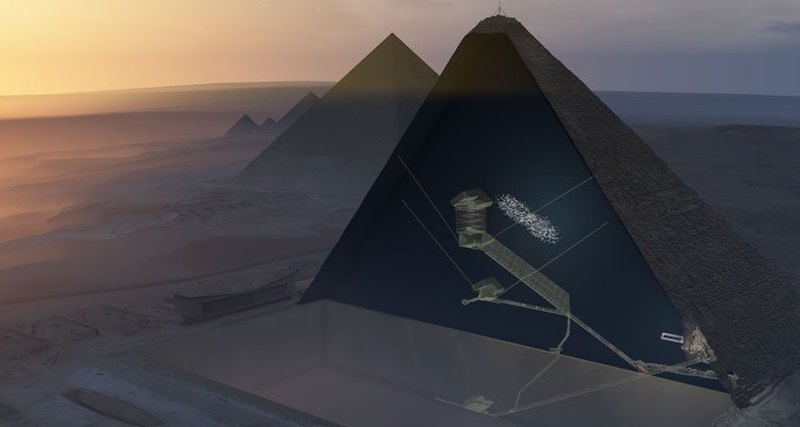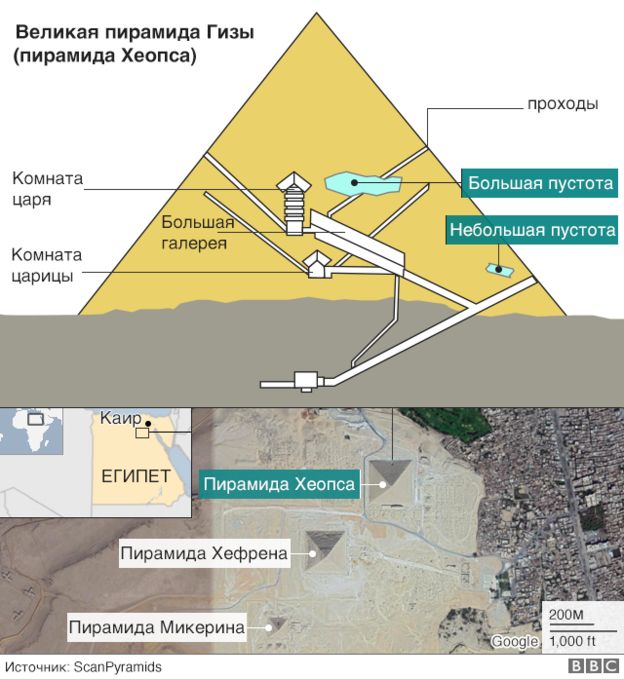In the pyramid of Cheops discovered a large room

Egyptian pyramids are not so mysterious objects as they were half a century ago. Scientists understood how they were built, even calculated how much beer, bread and other supplies went to feed the builders. Nevertheless, it is not so easy to explore a massive stone monument, perhaps there are still many secrets hidden in it.
One of them manifested itself quite recently. We are talking about a large emptiness , probably some kind of room about 30 meters long and about two meters high. This emptiness is in the very center of the pyramid. Unfortunately, it is not clear what is inside, since there is no access to the cavity.
Yes, and it was only discovered using the technology of muon radiography . This method allows finding cavities hidden behind a thick layer of rocks impermeable to most types of radiation. The basis of the method is the high-energy particles that come to us from space. Scientists track the flow of charged particles, which are formed when cosmic rays collide with gas molecules in the air. Some of the new elements are muons, which are detected by the new method.
They move at speeds that are close to the speed of light. Well, by the rate of muon absorption by the surface of the planet, you can determine the structure of the object through which the particles pass.
The project, which helped to discover the emptiness in the pyramid, was attended by archaeologists and scientists of other specialties from Egypt, France, Canada, and Japan. On the "lumen" of the object and the analysis of the results took about two years. The pyramid of Cheops is about 4.5 thousand years old. So if the room really exists and there is something inside, then it has remained untouched for four and a half dozen centuries.
By the way, the pyramid of Cheops is the largest among all its "relatives" from the complex of the pyramids of Giza on the banks of the Nile.

Over the years of research, scientists have found three large rooms, aisles and galleries in the pyramid. As for the cavity found now, the scientists do not know the angle of its inclination, the possible division into separate rooms and so on. The problem is that the scan gives only approximate results. However, none of the other research methods make it possible to determine the location of voids in the rock.
Scientists do not yet know what they found. The fact is that the creators of the pyramids often created special compartments that helped to avoid structural destruction due to the pressure of massive rock blocks. For example, there are five such voids at once over the King's Room.
Some scientists believe that the find may not really matter - since there is no access to it, it may well be that access was not planned. However, to find out what exactly this void represents inside the pyramid is worth it. This should be done even if there is even a small probability of the existence of historical artifacts in this room.
On the other hand, there are opinions that contradict the above. Hani Helal of Cairo University argues that the void is too big to serve only as a tool for distributing pressure across the volume of the pyramid.
“We are trying to figure out the structure of the pyramids and find out exactly how they were built. Eminent Egyptologists, archaeologists, and architects have several hypotheses about this, ”said Helal. He also added that high-class specialists will have to deal with emptiness.
The team that implemented the project worked immediately with three types of muon telescopes, all of which showed approximately equal results of the analysis of the distribution of muons. Using this method, you can detect only large objects with dimensions of tens of meters. Smaller determine difficult.

Great gallery in the pyramid of Cheops
Currently, scientists are discussing the possibility of studying the detected premises. There are already some thoughts on this, but, unfortunately, the permission of the Egyptian authorities is necessary for their implementation. Why permission? Archaeologists want to drill a small hole in the stone block that blocks access to the void. After that, a small robot with a camera will be passed into the hole.
There is one detail that can clarify the purpose of the cavity discovered by scientists. The fact is that it is located just above the Great Gallery of the Pyramid of Khufu. It may well be that during the construction of the object the niche was used as an auxiliary space for creating the gallery itself. So far this is only a guess, the real state of things has to be clarified by scientists.
All Articles